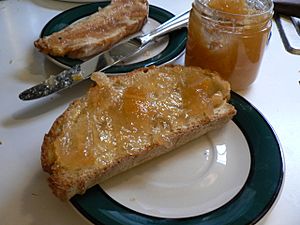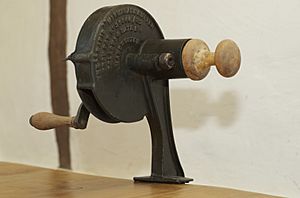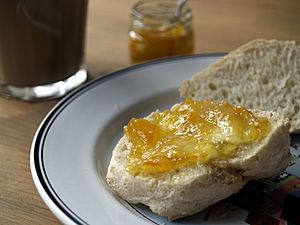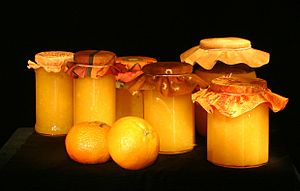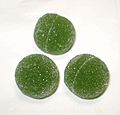Marmalade facts for kids
Marmalade is a type of fruit preserve made from the juice and peel of citrus fruits. It's cooked with sugar and water until it becomes thick. You can make marmalade from many citrus fruits like kumquats, lemons, limes, grapefruits, mandarins, sweet oranges, and bergamots. You can also mix them!
For a long time, the best fruit for marmalade in Britain has been the Spanish Seville orange. This orange is great because it has a lot of pectin. Pectin is a natural substance in fruit that helps marmalade get its thick, jelly-like texture. The peel of the Seville orange also gives marmalade its special bitter taste.
The word "marmalade" usually means a preserve with fruit peel in it, which helps tell it apart from jam. However, it can also be different from jam because of the type of fruit used. Long ago, the word "marmalade" was used for other kinds of fruit preserves too, not just citrus ones.
Contents
Where Did Marmalade Come From?
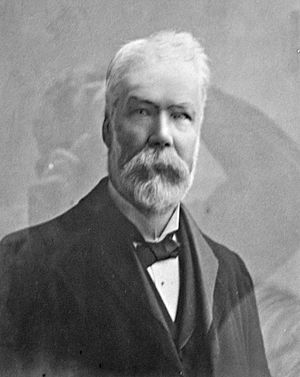
The ancient Romans learned from the Greeks that quinces, a type of fruit, would become firm when cooked slowly with honey and then cooled. They didn't know about fruit pectin back then, but they saw the effect! The Greek word for "honey fruit" eventually led to the Portuguese word marmelo, which means quince.
A Roman cookbook even has a recipe for preserving whole quinces in honey. Later, in the Byzantine Empire, quince and lemon preserves were mentioned in a book about royal banquets.
During the Middle Ages, quince preserves were called cotignac in French. By the 16th century, people started using fewer spices in these preserves.
In 1524, Henry VIII of England received a "box of marmalade" from Portugal. This was likely marmelada, which was a solid quince paste. This type of solid quince paste is still made and sold in southern Europe today.
One of the earliest recipes for orange marmalade was found in an English recipe book from 1677. It made a firm, dark paste. But it was the Scots who really helped make marmalade popular as a spread. In the 18th century, Scottish recipes started using more water, making the preserve less solid.
The first printed recipe for orange marmalade was in Mary Kettilby's cookbook from 1714. Her recipe used whole oranges, lemon juice, and sugar. The lemon juice's acid helped the marmalade set because of the pectin. Kettilby wrote to "boil the whole pretty fast 'till it will jelly." This is the first time the word "jelly" was used for marmalade making. Her method made the marmalade brighter and more clear, like modern marmalade.
The Scots were the first to eat marmalade at breakfast. In the 19th century, the English started doing the same. Marmalade became an important part of British meals. For example, writer James Boswell mentioned eating it for breakfast in Scotland in 1773.
What Does the Word "Marmalade" Mean?
The word "marmalade" came into the English language around 1480. It came from the French word marmelade, which came from the Portuguese word marmelada. The oldest known use of this Portuguese word is from a play written in 1521.
The meaning of "marmalade" changed in English during the 17th century. This was when citrus fruits became more common in England. That's when it started to mean a preserve made from citrus fruits.
In Portuguese, marmelada still means a preserve made from quinces, or quince cheese. The Portuguese word marmelo (quince) comes from the Latin word melimelum, meaning "honey apple." This, in turn, came from the ancient Greek word μελίμηλον (melímēlon), which means "honey apple" (from μέλι for "honey" and μήλον for "apple").
There's a fun, but untrue, story that Mary, Queen of Scots, ate marmalade when she had a headache. The story says the name came from her maids whispering Marie est malade (Mary is ill). But this is just a legend; the word's real origin is not connected to Mary.
How "Marmalade" Is Used Around the World
In many parts of Europe and Latin America, words similar to "marmalade" are used for all kinds of fruit preserves. But in Britain, "marmalade" means only a preserve made from citrus fruits.
For example, in Portuguese, marmelada is only for quince jam. In Spanish, the word usually means what English speakers call jam. In Italian, marmellata means any jam or marmalade. The German word Marmelade also means both.
Dundee Marmalade
The Scottish city of Dundee is very famous for its marmalade. In 1797, James Keiller and his wife Janet opened a factory there. They started making "Dundee Marmalade," which was special because it had thick pieces of bitter Seville orange rind. Their business grew, and Dundee marmalade is still a well-known type today.
There's a Scottish legend about how orange marmalade was first made in Britain. The story says that a ship carrying oranges broke down in Dundee's port. Some clever locals then used the oranges to make marmalade.
Marmalade in Children's Books
Paddington Bear, a famous character in children's books, loves marmalade very much. He especially likes it in sandwiches and always carries some in his briefcase. Paddington Bear is even on the label of a popular, milder marmalade called Robertson's 'Golden Shred'. When the movie Paddington came out in 2014, marmalade sales in the UK went up a little!
Images for kids
-
Vihreät kuulat, green marmalade balls by Fazer
See also
 In Spanish: Mermelada para niños
In Spanish: Mermelada para niños


